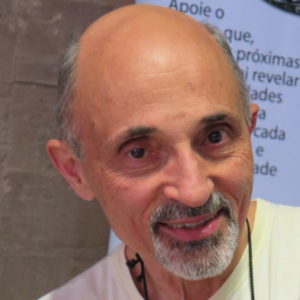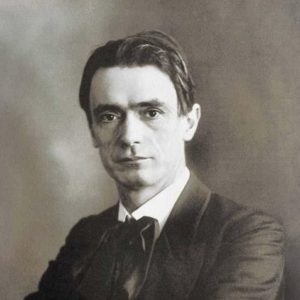INTRODUCTION – Education to face the challenges of the future
 by Rubens Salles
by Rubens Salles
“Our highest task must be to form free human beings who are capable of finding purpose and direction in their lives for themselves.” Rudolf Steiner
In 2019 we celebrate 100 years since the creation of the first school where the Waldorf Pedagogy was implemented. The objective of this book is to introduce the reader to the rich universe of this pedagogy, which is in full development in Brazil and in the world. It presents the philosophical and conceptual basis that supports it, as well as pedagogical aspects of early childhood education and elementary education, but the text does not exhaust the subject, which far exceeds its limits. To become a Waldorf teacher it is necessary to take a postgraduate course or teacher training course recognized by the Federation of Waldorf Schools in Brazil (FEWB). The specialization course for early childhood education in Waldorf Pedagogy requires around 770 class hours plus internships, and for elementary school also 770 class hours plus internships.(1)
Waldorf Pedagogy is part of a group of human activities that developed from Anthroposophy (from the Greek “anthropos”, man, and “sophia”, wisdom), a philosophical line conceived by the Austrian philosopher Rudolf Steiner, and which was born in the middle of of the social and economic chaos that followed the First World War.

Berta and Emil Molt
In November 1918 the First World War ended, and much of Europe was destroyed. With the impulse to overturn the old social models in force until then, people who were striving to build the Europe of the future were looking for new directions. One of these men was Emil Molt, director of the Waldorf-Astoria cigarette factory in Stuttgart, Germany. He and his wife Berta approached Rudolf Steiner, the founder of the anthroposophical movement, who at that time was one of the leaders of the movement for social renewal, and asked him to help them form a school for the children of factory workers, and to take over its pedagogical organization. Six months later, on September 7, 1919, the first school based on the pedagogy created by Rudolf Steiner, the Waldorf School, was opened, with 12 teachers and 256 students spread over 8 classes. Thus, it was a school created for the people, being revolutionary since its creation, because there were no grades or repetition of the year, and it did not separate boys and girls, which was common at that time. While materialism was the basis of concepts at that time, as it is today, Steiner proposed an education based on a holistic vision, which seeks the physical, mental and spiritual development of man, and his formation as a free and autonomous individual. Waldorf schools were persecuted by all forms of dictatorship and authoritarianism, having been banned by both Nazism and Communism.
Since the founding of the first Waldorf school, this movement has expanded. Today there are about 1092 Waldorf Elementary and/or High Schools in 64 countries and 1857 Waldorf Kindergartens (Infant Education Institutions) in 70 countries on 5 continents.(2) Although this pedagogy was born in Europe, today it it is applied in both Russia and the USA, in South American slums and Israel, Brazil, the new democracies of Eastern Europe, Nepal, India, China, Egypt, Japan, Kenya and many others countries, which proves to be a pedagogy that can be adapted to any culture. This is because it is based on a deep knowledge of the human being, and seeks to offer what the child needs at each stage of their development, always respecting their maturity. This makes these schools more interesting and welcoming to children.
Generally, each country has its federation of Waldorf schools, created and maintained by all schools, and whose objective is to care for Pedagogy in the country, guide schools, promote events, promote and guide courses for teacher training, represent schools before government agencies, etc. Thus, we have the Federation of Waldorf Schools in Brazil, which you can find out about at www.fewb.org.br. The Waldorf name is a registered trademark that may only be used by Waldorf schools affiliated with FEWB.
It is important to note that the Waldorf Schools, with the exception of some small Kindergartens, are non-profit community associations created for this purpose by groups of interested parents and teachers. This is not a commercial franchise. The fact that fathers and mothers dedicate their time and energy to the effort necessary to create a new school is an important parameter for us to evaluate how much Waldorf Pedagogy has been positioning itself as a recognized and desired path for education by thousands of families in Worldwide.
In Brazil, the first Waldorf school was founded in São Paulo in 1956, with the name Escola Higienópolis, and after a few years it was renamed Escola Waldorf Rudolf Steiner. FEWB – Federation of Waldorf Schools in Brazil was founded in 1998, and today there are 230 Waldorf schools among FEWB affiliates and new initiatives. There are a total of 138 attending Early Childhood Education(3), 59 schools serving Elementary School I, 18 attending Elementary School II, and 15 attending High School, distributed in 20 Brazilian states (Mar/2021),(4) serving 17,206 students (Feb/2019), with around 1,600 specialized teachers and 550 assistants. Waldorf Pedagogy is also applied in numerous day care centers, social organizations and in some public schools.
There are trained specialist teachers who do not have a Waldorf school in their municipality or region to work in, and so they teach in conventional schools, adapting what is possible, for the benefit of their students. There are also many teachers who learn elements of this pedagogy in free courses, and thus manage to enrich their pedagogical practice in conventional schools and in social organizations, both public and private. The community of educators who identify with Waldorf Pedagogy grows every day.
The training of teachers specialized in Waldorf Pedagogy in Brazil currently has 20 regional centers, supervised by the FEWB, which maintains a forum for their monitoring and integration, with periodic meetings where their coordinators exchange experiences and seek to maintain a collective learning process to always improve. the quality of courses. In 2018, Faculdade Rudolf Steiner was opened in São Paulo, which offers higher education in Pedagogy expanded by Anthroposophy, with postgraduate options in Waldorf Pedagogy for kindergarten, elementary or high school, among other options and extension courses.
National and international congresses are held frequently. During this century that has passed since the first Waldorf school was created, thousands of educators have contributed to the development of this pedagogy all over the world, including in Brazil. Several of them, in addition to Steiner, are cited in this book. This constant impulse of study and renewal follows Steiner's orientation in the sense that in the modern world we should not base ourselves on beliefs, but always seek to analyze the proposed concepts and verify their coherence according to our own parameters.
Today, the influence of Waldorf Pedagogy transcends the space of schools. Based on its concepts, the Alliance for Childhood was created in 1999, a movement that today encompasses organizations from different areas and philosophical currents, with representations in countries in Europe, the Americas, Africa and Asia, including Brazil, all united in defense of childhood, as they believe that childhood, an essential part of each person's existence, needs protection and care. Its mission is to make society aware of the importance of a healthy childhood for the development of human beings capable of building a society based on a culture of peace, environmental sustainability and respect for all differences.(5)
Another social impact initiative created from Waldorf Pedagogy is Emergency Pedagogy, which began to be developed in 2006, when German Waldorf professor Bernd Ruf experienced the traumatic situation to which young Lebanese affected by the war between Israel and the Hezbollah. Based on this experience, he led the formation of a group of pedagogues and therapists who were willing to provide emergency care to help heal the emotional wounds of children and young people in the region, and thus prevent their traumas from becoming chronic. Since then, the movement has grown and works to assist victims of conflicts and catastrophes in the most diverse countries, so that emotionally wounded children regain confidence in themselves, in the other and in the world, and are able to, one day, act to transform themselves. him in a better place. In 2016, the Emergency Pedagogy Association in Brazil was created, which trains educators who deal with children and young people in situations of social vulnerability, having already acted in interventions in Brazil and in other countries.(6)
In these interventions, several principles and practices of Waldorf Pedagogy are used, which teachers use in the daily lives of schools. A rhythm is structured for daily activities, as this brings more security. In it, a time for playing is established, rhythmic exercises, eurythmy, sports, games and dances, and artistic activities, such as painting, drawing, theater, music, etc., are proposed that can help children and young people to deal with their traumas. The main objective is to establish bonds with children that encourage trust and stability.
“During a disaster, it is common for many children to experience feelings of helplessness, loneliness and abandonment. Your relationship with your own body, with the world and with other people suffers a maladjustment due to trauma. For traumatized children and youth, establishing bonds and relationships is therefore one of the most important pedagogical tasks.”(7) Bernd Ruf
Since 2006, more than 50 emergency pedagogy interventions have taken place in countries that have suffered from major catastrophes and wars, such as Japan, Sumatra, Gaza Strip, Haiti, Nepal, Kurdistan/Iraq, China and Kenya, among others. The international actions are coordinated by the Associação Amigos da Educação Waldorf(8), based in Germany, which supports initiatives related to Waldorf pedagogy around the world.
Rudolf Steiner and Anthroposophy
 Rudolf Steiner was born on February 27, 1861 in Donji Kraljevec, in the region called Medjimurje, Croatia, between Hungary and Slovenia, in the then Austro-Hungarian Empire, and carried out his higher studies of exact sciences in Vienna. In 1883 he was invited to work at the Goethe-Schiller Archive in Weimar, Germany, to dedicate himself to editing the scientific writings of Johann Wolfgang von Goethe – who became an important influence on his work – developing from there a great cognitive interest and consequent philosophical literary activity. As a result of this work, he wrote in 1886 Basic Lines of a Theory of Knowledge of the Goetheanistic Conception of the World, with Special Reference to Schiller. In 1891 he published his doctoral thesis, entitled Truth and Science, and in 1894 he published his basic work: The Philosophy of Liberty. After some years working as a literary writer in Berlin, he began to dedicate himself to an intense activity as a writer and lecturer, with the aim of exposing and disseminating the results of his ideas and spiritual philosophical research, initially within the scope of the Theosophical Society and later in the of the Anthroposophical Society, which he founded. Steiner used meditation-trained thinking as a means of research, which allowed him to objectively and consciously observe the world beyond matter. According to Waldemar Setzer, Steiner based his research on understanding, and not on feelings, he developed his own worldview, having given absolutely original philosophical and practical contributions that go back to no one.(9)
Rudolf Steiner was born on February 27, 1861 in Donji Kraljevec, in the region called Medjimurje, Croatia, between Hungary and Slovenia, in the then Austro-Hungarian Empire, and carried out his higher studies of exact sciences in Vienna. In 1883 he was invited to work at the Goethe-Schiller Archive in Weimar, Germany, to dedicate himself to editing the scientific writings of Johann Wolfgang von Goethe – who became an important influence on his work – developing from there a great cognitive interest and consequent philosophical literary activity. As a result of this work, he wrote in 1886 Basic Lines of a Theory of Knowledge of the Goetheanistic Conception of the World, with Special Reference to Schiller. In 1891 he published his doctoral thesis, entitled Truth and Science, and in 1894 he published his basic work: The Philosophy of Liberty. After some years working as a literary writer in Berlin, he began to dedicate himself to an intense activity as a writer and lecturer, with the aim of exposing and disseminating the results of his ideas and spiritual philosophical research, initially within the scope of the Theosophical Society and later in the of the Anthroposophical Society, which he founded. Steiner used meditation-trained thinking as a means of research, which allowed him to objectively and consciously observe the world beyond matter. According to Waldemar Setzer, Steiner based his research on understanding, and not on feelings, he developed his own worldview, having given absolutely original philosophical and practical contributions that go back to no one.(9)
The term Anthroposophy was used for the first time by Steiner when he gave the lecture “From Zarathustra to Nietzsche – History of the evolution of humanity based on cosmovisions from primordial times to the present, or Anthroposophy”. He has written 28 books and delivered over 5,000 lectures, published in about 330 volumes, making major contributions to the fields of the arts, social organization, pedagogy, psychology, medicine, pharmacology, agriculture, architecture, therapeutic pedagogy for children with disabilities, etc., the principles of Anthroposophy being adopted in institutions around the world. Rudolf Steiner lived deeply committed to the destinies of the Earth and the human being and died in Dornach, Switzerland, in 1925.
Bibliography
- Rudolf Steiner College – São Paulo SP
- March 2021 data from Friends of Waldorf Education – https://www.freunde-waldorf.de/en/
- In November 2019 there were 200 Kindergartens, but 62 closed during the pandemic.
- Information provided by FEWB – Federation of Waldorf Schools in Brazil, in March 2021.
- Alliance for Childhood – http://aliancapelainfancia.org.br/
- Emergency Pedagogy – http://pedagogiadeemergencia.org
- RUF, Bernd. Destroys and Traumas – anthroposophical foundations for interventions with Emergency Pedagogy, 2018, pg 132
- Friends of Waldorf Education Association – https://www.freunde-waldorf.de/en/
- SETZER, Waldemar. Comments on the chapter “Rudolf Steiner” from the book 50 Great Educators, 2008
****


